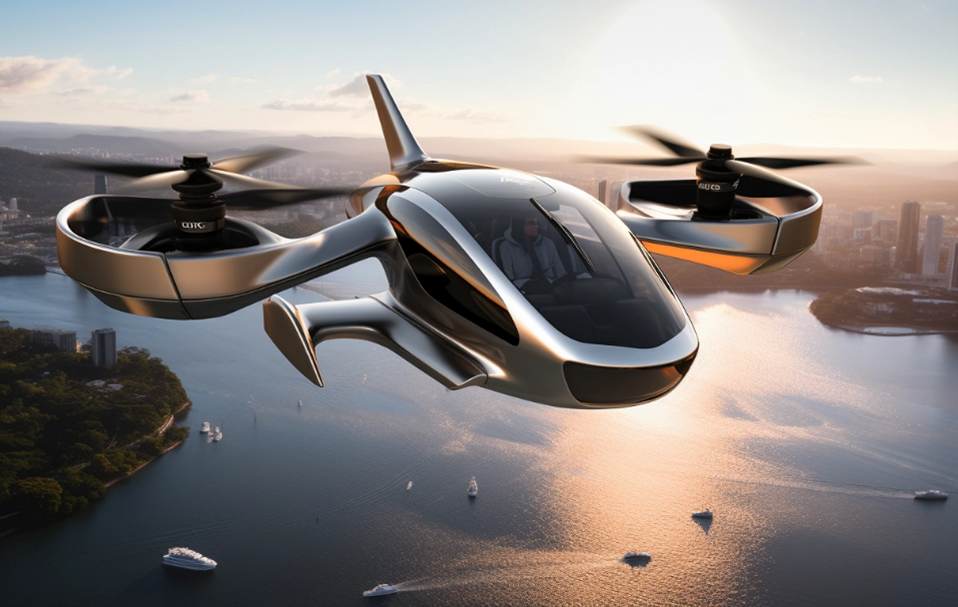How AI can fast track the developments our aviation sector desperately needs

Aircraft concepts have been conceived in unison with Midjourney AI. Image credit: Thomas Luke
In summary
With the help of artificial intelligence, new aircraft designs that meet modern demands could be a reality as soon as 2025
Thomas Luke, PhD candidate at Swinburne University of Technology’s Aerostructures Innovation Research (AIR) Hub is investigating how AI can be used in the design phase of an aeroplane
GenAI has the potential to address existing issues within the aviation sector like safety and provide insight on how the industry can improve
The aviation industry has been plagued with issues post-pandemic, from recent airline safety concerns to mass holiday delays and cancellations.
But, with the help of artificial intelligence, new aircraft designs that meet modern demands could be a reality as soon as 2025 and help alleviate these concerns.
Thomas Luke, PhD candidate at Swinburne University of Technology’s Aerostructures Innovation Research (AIR) Hub, says that AI should be a crucial consideration in the industry’s transformation and could help Australia become a global aviation leader.

PhD student Thomas Luke presents his ideas on radical design-driven innovation
“We're on the precipice of a big transition, with new modes of transport to be used by 2025. AI can radically innovate this space and allows Australia to fast-track projects in the aerospace sector.”
Thomas is investigating how AI can be used in the design phase of an aeroplane using a text-to-image generator and has developed new concepts that could be adapted by industry to make innovative new aeroplanes.
Traditional illustration and concept renderings can take days and valuable resources to produce. Thomas’ designs are created within 20 seconds.
“This new horizon of aerospace demands a different approach,” he says. “Small aeroplanes are super functional and are achievable to fast track into the industry for public use.”

Aircraft concepts designed with the help of AI. Image Credit: Thomas Luke
The future of aviation
With the help of emergent AI, Advanced Air Mobility (AAM) offers a glimpse into the future of electric vertical takeoff and landing (eVTOLs) vehicles that are expected to play a pivotal role in the future of aviation.
“AAM represents a significant evolution in aviation,” says Thomas. “It envisions the future of air transportation, embracing modern technologies, materials, processes, user experience and innovative thinking to solve complex problems. AAM and its unique air vehicles will encounter new challenges; this makes it an opportune moment to weave AI into the fabric of this emerging industry from the ground up.”
GenAI has the potential to address existing issues within the aviation sector. It helps tackle pressing matters like safety and provides insights into how the industry can evolve and improve.
Thomas says GenAI serves as an invaluable 'co-author’, empowering professionals to enhance their work. “This allows for re-examining existing challenges with fresh perspectives and tackling new tasks more innovatively than traditional approaches,” he explains.
Though the aviation sector’s complexity cannot be understated, he hopes that AI can ease the load among a struggling industry.
“AI tools offers a vision of the future where exploring a broader range of solutions becomes more efficient and accelerates our progress so that Australia becomes an aviation leader worldwide.”
-
Media Enquiries
Related articles
-

- Technology
- Aviation
- Sustainability
Swinburne partners with Latrobe City Council to propel Victoria’s Advanced Air Mobility precinct
Swinburne has become the first Foundation Member of the newly established Latrobe Aerospace Technology Precinct.
Friday 03 May 2024 -

- Aviation
How AI can fast track the developments our aviation sector desperately needs
With the help of artificial intelligence, new aircraft designs that meet modern demands could be a reality as soon as 2025 and help alleviate concerns like safety.Thursday 18 January 2024 -

- Technology
- Aviation
Swinburne’s AIR Hub achieves hydrogen flight
Swinburne University of Technology’s Aerostructures Innovation Research Hub (AIR Hub) has successfully completed the first flight of an Australian-developed hydrogen fuel cell electric powered VTOL drone.
Tuesday 24 October 2023 -

- Aviation
AIR Pass accelerating success for aerospace innovation
Swinburne University’s AIR Pass program has accelerated Dovetail’s development and progressed its goal of accelerating decarbonisation in the aviation sector.
Wednesday 16 August 2023 -

- University
- Aviation
New AIR Hub partnership driving innovation and industry engagement
Swinburne’s Aerostructures Innovation Research (AIR) Hub has partnered with the Australian Mathematical Sciences Institute’s (ASMI’s) APR.Intern program to increase uptake in aerospace PhD internship projects by mid 2024.
Thursday 27 April 2023

